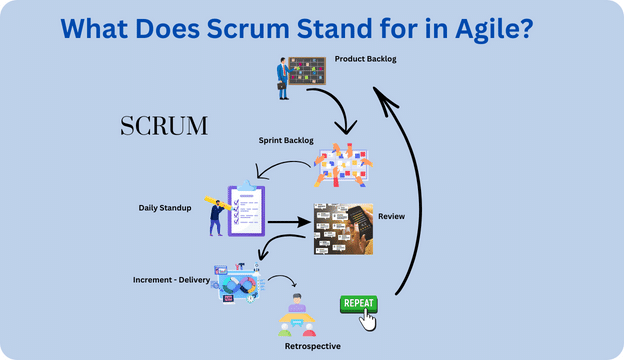
Introduction
The question what does scrum stand for in agile could confuse you if you have not fully studied about Agile and Scrum. In Agile software development model, Scrum is not an acronym. It is a framework for managing and organizing projects. The term “Scrum” comes from the sport of rugby, where it refers to a formation of players who work together to restart the game.
In scrum cross-functional teams work together in short, time-boxed iterations to develop and deliver high-quality software or products.

In this blog i will highlight different activities of the scrum that will develop a base for you to work in the organization using the said model. But before that, i would like to tell little bit about Agile first.
What is Agile?
Agile is a software development model like waterfall. Unlike waterfall agile is iterative or incremental in nature. The ever simplest explanation of agile you could found on the internet.
Agile Values
Agile, a set of principles and values that prioritize:
- Individuals and interactions over processes and tools.
- Working software over comprehensive documentation.
- Customer collaboration over contract negotiation.
- Responding to change over following a plan.
These four are the values of agile, also called manifesto of agile.
Principles of Agile
Apart from these values agile also has twelve principles which are:
- Customer satisfaction through early and continuous software delivery.
- Welcome changing requirements, even late in development.
- Deliver working software frequently, with a preference for shorter timescales.
- Collaborate with customers and stakeholders throughout the project.
- Build projects around motivated individuals; give them the environment and support they need.
- Use face-to-face communication as much as possible.
- Working software is the primary measure of progress.
- Maintain a sustainable pace of work for the team.
- Strive for technical excellence and good design.
- Keep things simple and maximize the amount of work not done.
- Allow self-organizing teams to make decisions.
- Reflect regularly on team performance and adjust as needed.
There are much more in agile that you can find on the internet but i will keep it simple and will talk about just one more concept that is, phases of agile.
Phases of Agile Model
The following six phases are most commonly used in the agile mode.
- Requirements Gathering
- Designing Requirements
- Construction/Iteration
- Testing/Quality Assurance
- Deployment
- Feedback
Advantages of Agile
- Flexibility
- Collaboration
Drawbacks of Agile
- lack of documentation
Scrum | What Does Scrum Stand for in Agile?
Scrum is an Agile framework that emphasizes collaboration, iterative development, and delivering value in short, time-boxed cycles called sprints.
What are the Roles in Scrum?
There are three roles in this framework which are:
- Product Owner: The Product Owner represents the customer’s needs, prioritizes work, and makes product decisions.
- Scrum Master: The Scrum Master facilitates the Scrum process, removes obstacles, and supports the team in achieving their goals.
- Development Team: The Development Team designs, builds, and tests the product, delivering valuable increments in each sprint.
In this framework, product owner add items that is called product backlog items or simply PBIs in the product catalog, from where the refined PBIs are added in another catalog that is called sprint catalog.
Sprint Planning
Sprint is nothing but a time box that could be of one week, two week or a month at max. The scrum starts from an event called sprint planning, the process in which the items are moved from the product catalog to the sprint catalog.
Daily Stand up
Then each day a daily stand up occurred, where progress is shared, individuals tells about there work, what tasks they have done, what they will do, they also discuss impediment if there is any.
Sprint Review
It is Held at the end of each sprint. Team demonstrates the completed work to stakeholders and Collects feedback to inform future work.
Sprint Retrospective
the last even of each sprint where team reflects on their performance during the sprint.
Identifies what went well that should be kept continued, what went wrong, to avoid in in upcoming sprint, and areas for improvement in the process.
Scrum Values | (FROCC)
- Focus: The team maintains a laser focus on the sprint goal and strives to complete the selected work without unnecessary distractions.
- Respect: Team members respect each other’s expertise, opinions, and contributions, creating a collaborative and supportive environment.
- Openness: Transparency and open communication are encouraged, allowing team members to share information, progress, and challenges.
- Commitment: Team members commit to achieving the goals of the sprint and delivering high-quality work.
- Courage: Team members have the courage to take on challenges, admit when they don’t know something, and address issues head-on.
What are artifacts in Scrum?
Artifacts are documents or items that provide transparency and information to the Scrum team and stakeholders about the product’s progress and work to be done. There are three primary artifacts:
- Product Backlog: A prioritized list of all the features, user stories, and requirements for the product. It represents the work to be done in the project and is continually refined and updated.
- Sprint Backlog: A subset of items from the product backlog that the team commits to completing during a specific sprint. It contains the tasks and user stories to be worked on during that sprint.
- Increment: The sum of all the completed product backlog items at the end of a sprint. It represents the latest version of the product with all the functionality that has been developed and is potentially shippable.
Alternate Agile Frameworks
- Kanban: Emphasizes visualizing work, limiting work in progress, and optimizing flow, making it suitable for continuous delivery and teams with fluctuating workloads.
- Extreme Programming (XP): Focuses on technical excellence, collaboration, and customer involvement, with practices like test-driven development (TDD) and pair programming.
Apart from these two there are many more, explore it on your own.
Conclusion | What Does Scrum Stand for in Agile?
To sum up, the required information about Agile is available in this blog, which can assist you in working within organizations that utilize Agile methodologies. If you’re wondering, “What Does Scrum Stand for in Agile?” it’s important to understand that Scrum is not an acronym; rather, it’s a structured approach to managing projects.
Here are the key components of the Scrum framework includes Product Backlog, Ongoing Refinement, Sprint Planning, Daily Stand-Ups, Sprint Review, Incremental Delivery, Retrospective Meetings, and Iterative Cycle.


Nice article
🙂